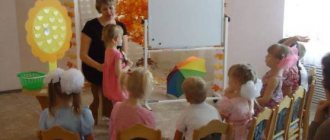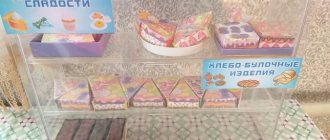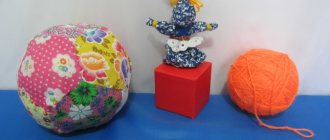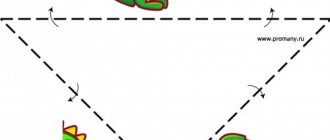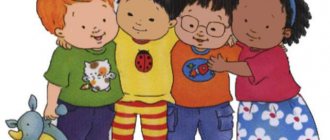Abstract to the methodological development “The best theatrical production in kindergarten”
Svetlana Demidova
Abstract to the methodological development “The best theatrical production in kindergarten”
Theatrical activities of children in kindergarten in a modern preschool educational institution are one of the most effective ways of working with children, in which the learning principle of learning by playing is most clearly manifested. Among the areas of work on the development of children through theatrical activities, dramatization occupies a special place, which introduces children to the world of beauty, develops the sphere of feelings, emotionally liberates, relieves tension, develops and activates speech, and influences moral values. The success of children's theatrical activities depends on the interaction and correct rational distribution of the content of the developmental work of the teacher in preparing children for staging performances. This methodological development reveals the step-by-step creation of a fairy tale performance in the senior group of a kindergarten, in which only children participate and is focused on solving the educational problems of the Federal State Educational Standard of Preschool Education in the joint activities of adults and children and in the independent activities of children.
Introduction
“The theater is a magical world! He gives lessons in beauty, morality and ethics. And the richer they are, the more successful the development of the spiritual world of children is.”
B. M. Teplov
Relevance.
This topic was chosen in order to activate the creative potential of children when staging a fairy tale and to show the role of the teacher in organizing theatrical activities. In modern society, the social prestige of intelligence and scientific knowledge has increased. Connected with this is the desire to give children knowledge, to teach them to read, write and count, and not the ability to feel, think, and create. There is a problem that has been dealt with by many teachers and psychologists: N. F. Sorokina, E. V. Migunova,
T. S. Grigorieva. Some children experience fears, breakdowns, and lethargy, while others, on the contrary, have swagger and fussiness, lack voluntary behavior skills, and have insufficiently developed memory and attention. The shortest way to emotionally liberate a child, relieve tension, teach feeling and artistic imagination. Joint creative activity involves even insufficiently active children in the production process, helping them overcome shyness and inhibition.
The importance of work on organizing theatrical activities is also reflected in the Federal State Educational Standard for Education. The document emphasizes that it is necessary to create conditions that would open up opportunities “for the development of initiative and creative abilities of children through cooperation with adults and peers.” As experience has shown, the effectiveness of such interaction largely depends on the correct and rational distribution of the content of the teacher’s developmental work in preparing children for staging performances.
Main part
In April, “Theater Week” was held in our kindergarten and group.
The goal of my work with children was to enrich the cognitive experience on the topic “Theater”: development, practical skills, creating conditions for staging V. G. Suteev’s fairy tale “Under the Mushroom” and dramatizing the fairy tale, applying the accumulated experience in independent activities. To achieve this goal, tasks were set.
Tasks:
Social and communicative development.
-Develop social and emotional intelligence, emotional responsiveness, empathy;
-Develop readiness for joint activities with peers.
-Cultivate positive interaction, the ability to negotiate and distribute roles
Cognitive development;
-Create interest and motivation for the activity performed.
Speech development:
-Develop dialogic speech, monologue speech and the ability to convey images using expressive means.
-Deepen the emotional perception of a literary text, enrich gaming experience, skills, deepen theatrical gaming experience through mastering different types of theater.
Artistic and aesthetic development:
- Stimulate and promote the development of creative skills in visual and musical activities.
— Enrichment of RPPS in the group.
-Involving parents in creating conditions for children’s theatrical activities.
Physical development:
— training fine motor skills of the hands, orientation in space.
Novelty: In accordance with the Federal State Educational Standard for Educational Education, tasks are implemented that are focused on the socialization and individualization of personality development, nurturing the need for spiritual enrichment of the child, the ability to interact with peers, mastering communication skills, collective creativity, and self-confidence.
To organize the teacher’s guidance of theatrical activities with children in a group in the following areas: cognitive development, speech development, artistic and aesthetic development, social and communicative, physical, I carried out methodological forms and techniques with children
This includes looking at books, reading, looking at illustrations, storytelling, conversations, didactic games, exercise games, making simple paraphernalia, choosing roles by lot (at the request of the children, stimulation, figurative play sketches, classes on cognitive and speech development, joint artistic creative activities, problem situations, relaxation exercises, individual conversations, preparation of invitations and posters, role-playing game "theater", the use of characters in everyday communication.
To directly stage the performance, I chose the following algorithm:
1. Reading a fairy tale, looking at the illustrations and discussing it with children.
2. Dividing the fairy tale into episodes and retelling them by children.
3. Work on episodes in the form of sketches, game exercises with the proposed fragments of a fairy tale in a poetic version.
4. Search for an image (defining the character of the hero, manner of moving and speaking)
5. Creation of scenery and costumes, posters, invitations, dance creation, musical arrangement of episodes.
6. Individual work on the text (dialogues, work on expressiveness.
7. Rehearsal in costumes and scenery.
8. Premiere of the play. (Reruns featuring other children)
9. Making a film.
10. Acting out a fairy tale in independent play activities.
As a result of my work with children, the theatrical fairy tale “Under the Mushroom” was shown to four kindergarten groups. There were re-runs of the play for parents on Open Day with the participation of other children in the group. The children “play” the fairy tale in independent play activities.
New attributes for theatrical games were introduced into the developing environment of the theatrical zone “We invite you to a fairy tale”: a shadow theater based on the fairy tale “Teremok”; theater on magnets “Three Bears”; tabletop theater on stands “Geese-Swans”; a development zone “Purple Forest” (flannelograph) and fairy tales on flannelgraph “Under the Mushroom”, “The Snow Queen” were created; costumes for the director's games sparrow, ant, butterfly, mushroom and scenery for it - large models of flowers; toys for theatricalization of the fairy tale “The Three Little Pigs” - toys and house models; didactic game
"Guess the fairy tale."
I have replenished and use in my work the methodological piggy bank in the group for guiding the theatrical activities of children (fairy tale scenarios, notes, GCD, methods, articles).
Work was carried out with parents to create conditions for theatrical activities: participation in the creation of costumes. Together with their children, the parents got acquainted with theatrical productions in the city; We had a conversation (recommended by the teacher) with our children about the culture of behavior in the theater.
Conclusion
In conclusion, I would like to note that the key figure in the organization of theatrical activities, namely the staging of performances in kindergarten, is the teacher; the result of joint theatrical activities with children depends on his responsibility, consistency, work algorithm, and competence. The result of staging the fairy tale “Under the Mushroom” in the group was the improvement of children’s performing skills and sense of partnership. Children learned to fantasize, modify, combine, and improvise based on their existing experience. In their games they began to use pantomime sketches and sketches for memorizing physical actions. In dramatization, children express themselves very emotionally and directly; the process of dramatization itself captures the child more than the result. Artistic abilities develop from performance to performance. Work on the development of theatrical activities and the formation of creative abilities brings tangible results. In the process of theatrical activity, a special, aesthetic attitude to the surrounding world develops, general mental processes develop: perception, imaginative thinking, imagination, memory, attention; dialogical speech develops, the ability to interact with peers, mastery of communication skills, collective creativity, and self-confidence.
Introduction
This work was written to help teachers of experimental sites for problem-based learning based on OTSM-TRIZ. The examples provided here illustrate the techniques used in this pedagogical approach. However, the author hopes that other teachers who want to describe their methodological developments will also find useful advice here.
The recommendations are described in the form of a template. By replacing the template text with the author’s text in accordance with these recommendations, the teacher will be able to create his own methodological development. This approach was borrowed from my supervisor, Professor V.V. Guzeev [1], whose dissertation research template was the basis for my own Ph.D. thesis.
The second section provides direct recommendations for creating a methodological development, and the third section contains a list of references used.
Composition and content of methodological development
Subject
Usually the topic is built on the principle: subject of research - object of research. The order of the parts of the title may vary.
The object indicates the area to which your development belongs, and the subject indicates what aspects, features you are going to change, the distinctive features of your technique. In other words, an object is the closest supersystem in which you work, and an object is that subsystem or feature that your work changes and improves.
Sometimes the wording itself indicates the GOAL - why this object needs to be improved.
Examples:
Using the Point of View (SUBJECT) model as a tool
integration of speech development and natural history courses (OBJECT)
to form a systemic perception and emotional attitude towards the world around us (GOAL).
The integration of natural history and speech development courses has been done before you, in this case this is the area in which you want to say your new word (object). But using the point of view model as a means to integrate these courses is something new that you have developed (subject).
The subject may have varying degrees of novelty, formulations such as “problems of using the technique...”, “features of using the technique... in the conditions...” are possible. In this case, the methodology itself will be the object (if it already existed before you), and the problems of its application, the features of its use in some new conditions will be the subject of research.
You may not be able to accurately formulate the topic right away. This is normal: if you are solving a pedagogical problem, you are not required to immediately know by what means it will be possible to solve it. Therefore, the goal and object are important at the input, and the object can become clearer later. Recommendations for formulating goals are given below.
Author information
Author of the methodological development (last name – first name – patronymic, place of work and position, contact information: preferably – email address, yours or the school’s address).
Example: Ivanova, Anna Petrovna, primary school teacher at school No. 1, N, teacher of the 1st category, [email protected]
Conditions of use
In this section please indicate
— Student population, characteristics of the population (if any).
— The program within which your methodology is applied.
— If your development is based on the author’s methodology, indicate the name of the basic methodology and its authors.
Example:
— Primary grades (1-2).
— Speech development course as part of the Russian language course
— Methodology for compiling a descriptive story from a picture (Murashkovska I.N., Valums N.P.).
Relevance, purpose and objectives
A well-formulated goal largely determines the success of the entire work. You should not formulate goals in “general terms”: to develop thinking and imagination - the fact of achieving such a goal cannot be verified. Let us indicate the requirements for the formulation of goals and objectives:
1. The goal must be formulated very specifically, so that it can be divided into understandable tasks, the results of which can be verified. 2. The goal must be considered in the general system of goals, i.e. Not only the goal should be clear, but the subgoals (tasks) with the help of which it will be achieved and the supergoals to achieve which your goal is needed. 3. Objectives indicate the changes that should happen to the student and manifest themselves in his behavior or in the results of his work (for example, in the texts he writes) as a result of applying your methodology. They are described by perfective verbs: teach how to write riddles like...; teach to distinguish between the name and meaning of a sign; teach how to use the system operator to write questions about a historical event, etc. We advise teachers who are familiar with OTSM-TRIZ to describe changes using the “element – feature names – feature values” model.
Below are several steps that are useful to take in order to formulate high-quality goals and objectives. This fragment of text (in italics) does not need to be included in the methodological development; it is needed in the process of working on the material.
To correctly formulate your goals and objectives, try doing the following:
1. Answer the question: “what are you going to change with your development?” Describe the expected result: WAS... – IS... And then remove those changes that you did not achieve or achieved using another technique, leave only those that directly relate to your work.
Example: WAS: children give an oral answer about a natural object, haphazardly, using cliches, talk without pleasure, speak with difficulty. – BECOME: children compose a coherent, emotional, imaginative story, examine objects from different angles, use their own comparisons, and tell stories with enthusiasm.
2. Make a chain of “WHY?”, this will help you see the supersystem of goals.
Example. Children know how to compose a coherent, complete story - Why? – To perceive the world around us holistically and systematically. - For what? – To be conscious of the world around you. - For what? – To be able to change the world around us.
Children compose a figurative story using their own comparisons - Why? – To build your own emotional relationship to the world around you. - For what? – To better understand yourself and the world around you.
3. Make a chain “FOR THIS?”, this will help you see the subsystems of goals.
Children compose a figurative story - for this they highlight the most striking fragments of the whole; build metaphors...
By completing this exercise, you will be able to obtain material for three points of methodological development (see below).
1. We get the rationale for the relevance of your work from the chain “WHY?” see paragraph 2 (example: “It is important to teach a child to navigate in the modern dynamic world, to form his own emotional attitude to what surrounds him. The development of figurative speech and associative thinking is one of the main tools for developing an emotional attitude to the world. No less important is the formation holistic, systemic perception of the surrounding world, necessary for a person to detect and solve the problems that arise before him. Together, systemic and figurative descriptions allow one to emotionally experience and appropriate methods of systemic perception of the world"). 2. The purpose of the work is to compare the initial situation (Was) with expectations (BECAME), see point 1 (example: “Teach the construction of a figurative story about an object based on the use of the “Point of View” model”). 3. Tasks - from the chain “WHAT?” see point 3 (example: “Teach to identify the signs of objects on behalf of which the story is built; teach to highlight the signs of surrounding objects that are important from the point of view of the narrator; teach to build figurative comparisons on behalf of the narrator; teach to build systemic comparisons on behalf of the narrator, combining images with unified system").
Facilities
Models, tools, methods
Indicate the models, tools, methods that are used in your development.
Example: The following models are used: “Element – feature name – feature value”, “Point of view”, morphological analysis.
Visual aids
Describe the visual aids you use. If well-known manuals described earlier are used, list them and provide links to the materials in which they are described.
Example: the manual “Circles of Lull” is used (link).
Description of the technique
The description of the methodology can be performed in various forms - it depends on its content.
The main problem of the description is that most of the methods we use are not implemented within one or several lessons, but require a more flexible training system. There is often a situation when the transition to a new stage provides a series of exercises from the previous stage, which can be carried out in any sequence. In this case, it is convenient to present the stages in the form of a diagram (Fig. 1). If your methodological development fits into a clear sequence of steps, there is no need for a diagram.
|
|
The example (Fig. 2) shows a fragment of the description of the methodology, which shows how individual exercises are connected to each other. The “compare an object on behalf of some wizard” exercise may be offered in different sequences, but they precede the system comparison. Empathy can be introduced in parallel with the “What is it like?” exercise. “Systemic empathy” must be preceded by empathy and systemic comparison.
For readers who are not familiar with OTSM-TRIZ pedagogy, we will explain the content of Figure 2. In the methods of developing speech and imagination, images of wizards are used, personifying the methods of transforming objects (Murashkovska I.N., Sidorchuk T.A.). Deli-Come divides objects into parts and combines the parts into a whole; Giant-Little One reduces or increases the size of objects, Lag-Run-Run moves objects along the time line.
If you have presented such a diagram, your next task is to describe each exercise in more detail. This can be done, for example, in the form of a table.
Table 1. Composition of the method
| Task, exercise, procedure | What does a teacher do | What are the children doing | Time, order of work | Recommendations, settings | What happens as a result |
| Compare an object with any other objects | Offers objects, asks questions | Answer questions | 3-5 minutes at the beginning of the lesson. The training is carried out until the result is achieved | First, choose objects that children know and have interesting shapes. Set up children for original answers: (“Vasya compared a boot with a pipe, Masha - with a canal. And the wizard D-D grouped the answers of Vasya and Masha (how?). Who will give an answer that D-D would be difficult to combine with the previous ones?” ) | Children find many comparisons and strive to find an original, unconventional comparison. |
Examples
Often in methodological developments, examples occupy the lion's share of the reader's space and attention. This sometimes leads to completely different results than the author expected. We have encountered cases where a teacher, having read the methodological material, is sincerely convinced that this material can only be used with the examples described in it. To use the “Picture without Stuttering” he needs the same picture with ducks, and the exercise “what does it look like?” must be done exclusively with a class key and glasses. The methodological development should be written in such a way that your colleagues do not copy it one-to-one, but can adapt it to the conditions of their educational process without violating the technology you propose.
Examples illustrate and make your proposals clearer and more specific. But in no case do they replace them.
Example. Let's play the game "What does it look like?" At the initial stage, use objects familiar to children with an interesting shape (for example, a key, glasses, a tree branch, an umbrella, etc.). Then move on to objects with other bright signs (a faucet with dripping water - sound, a burning light bulb - temperature, etc.).
Diagnostics
Diagnostics is a topic that requires separate discussion. As a rule, teachers’ methodological developments do not provide diagnostics; instead, they give examples of children’s works or statements. This enlivens the description of the technique, makes it more readable, but does not make it possible to evaluate the result. So, in lessons on speech development you can always expect 1-2 bright works, but this says absolutely nothing about the value of the methodology used in the lesson. Talented children write brightly and without special training, sometimes the teacher’s intervention only spoils the matter.
If the result of your methodological development can be represented by the creative products of students, it is necessary to show the work of at least 2/3 of the students in the class. This does not mean that you should waste time retyping children's essays or problems created by children. It is enough to attach photocopies of them to the description of the methodology. When publishing your design, we will decide how to illustrate it with children's work.
Another option is to use previously developed diagnostics. In this case, it is necessary to cite sources.
If you decide to offer your own diagnostics of the results of using your technique (for which you immediately deserve special thanks), then you need to answer two questions:
1. By what objects did you evaluate the results of your work? It can be
- observed behavior of children (children ask to conduct such lessons more often, bring additional material, play games suggested by the teacher during recess - such observations indicate an increase in motivation);
- products of children’s creative activity (essays, rules derived by children, tasks invented by them, etc.);
— results of performing special tasks, etc.
2. What characteristics will you evaluate?
It can be
- the presence of certain statements by students in the process of work,
- certain types of behavior of students (for example, if a child collects a piggy bank, practically without asking for help from the teacher and classmates and gets a result, one can judge independence in this type of activity); if a student uses systematic comparisons in the text, one can judge the maturity of the ability to make such comparisons);
— the number of correct answers to the proposed tasks; number of errors of a certain type, etc.
If you evaluate work in points, under no circumstances consider the arithmetic average as the result for the class. Two students who caught the flu that day, did not complete the work and received unities, will negate the results of at least four excellent students. Just count the number of twos, threes, fours, fives, etc. and the percentage of the number of this grade to the number of students who did the work. If the work is assessed, for example, on a ten-point scale, you can count the number of students whose results fall within certain intervals (for example, 0-5; 6-10; 11-20, etc.). The results can be reflected in a diagram.
conclusions
Briefly review what your work was about. What problems have you not yet been able to solve? Set yourself goals for the future.
Please do not forget that today many teachers in different parts of the country are waiting for your materials.
Bibliography and links
This list should contain all the materials that you used when creating your own methodological development.
— Materials published in the press (articles, books, textbooks, etc.);
- Materials posted on Internet sites (in this case, the address of the material on the network is given, for example, Murashkovska I.N., Valyums N.P. Picture without hesitation. [WWW document] URL https://trizminsk.org/e/ 2312.htm)
- Materials placed on CDs (example description: Nesterenko A.A., Belova G.V. Knowledge workshop: tools for problem-based learning based on OTSM-TRIZ // Effective educational technologies [Electronic resource]. - Electronic text , graphics, sound, video data (57.2 MB) - M.: LLC "Distance Technologies and Education", 2008. - Issue 1. - 1 electronic optical disk (CD-ROM) : sound ., color; 12 cm – 9.72 Mb.)
In the text of the article, references can be made to the publication numbers in the list, preferably indicating pages [1, pp. 34-35], or you can use the European system (full name of the author, year when the material was published), for example (Ivanov I.I. , 2007, p. 34).
If you are using ideas from colleagues that were communicated in a private conversation, instead of a link in brackets you can write (Ivanov I.I., private message)
